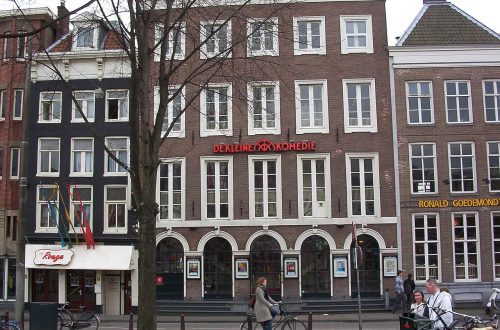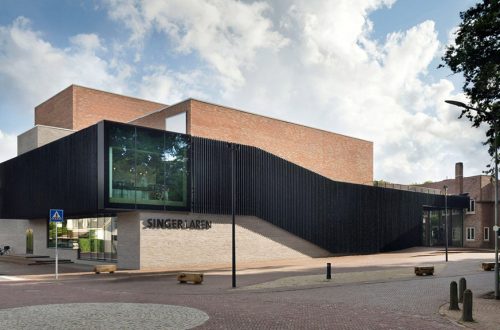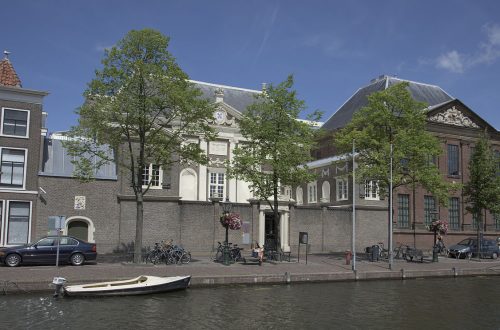
Comforting the community – Art as solace during the lockdown (Schiedam, the Netherlands)
As the lockdown started in The Netherlands, Stedelijk Museum Schiedam wanted to offer comfort to the inhabitants of the city Schiedam. By commissioning local artists to make their interpretation of comfort into a work of art and making their work into posters and postcards they spread the message of consolation throughout the city. Advertisement space was bought or donated and posters were offered to shops and other businesses to display. Volunteers delivered posters to the inhabitants who wanted them, and soon the city was full of expressions of solace from Schiedam, to Schiedam.
Background
Stedelijk Museum Schiedam (SMS) was founded in 1899 and is a museum for modern art, history, and society, focussing on the city of Schiedam. The building the museum has been situated in since 1940 was originally built as an infirmary at the end of the 18th century, continuing a tradition of housing the poor sick, and elderly that started around 1262. The museum has gladly taken over the tradition of hospitality and aims to be accessible for everyone, lowering the threshold a traditional museum often has.
As a municipal museum, SMS sees the importance of its role as not only a representative but as a connector, too. Their mission states that they want to be there for the inhabitants of the city, both for visitors and creators. Their local focus has created a bond between the museum and the inhabitants of the city and the museum continues to find new ways to include even the harder-to-reach audiences. One of the projects was ‘Kunstlogé’ (Guest art), where four households in Schiedam got delivered a piece of art from the museum to hang in their house for a week. After the week was over, they got to decide who could host it next. The museum chose a diverse audience, directly targeting communities who might not feel a connection with the museum yet.
Stedelijk Museum Schiedam consists of a small team of staff and volunteers and often works together with local companies, funds, and artists, building and keeping a cultural network throughout the city alive.
Description
In March 2020, when the Dutch government announced that the museums had to close their doors to the public, at first Stedelijk Museum Schiedam kept quiet. The circumstances surrounding the coronavirus scared everyone, and SMS decided to stay out of the public eye while the country came to terms with the pandemic, all the while making sure that their staff and volunteers were doing okay by creating phone trees. However, after a week of focussing inward, they started thinking about what they could do to provide comfort to the outside world. They started working together with the ‘De Groot Fonds’, a fund for Schiedam entrepreneurs in need. Later ‘Fonds Schiedam Vlaardingen’, a fund for social projects in Schiedam and the surrounding areas, also joined in in the project.
The ‘De Groot Fonds’ approached the museum first with the open suggestion to support any local artist through these times, as they were among those hit hardest as freelancers. Together they came up with an idea that would support multiple local artists and provide comfort for the inhabitants of Schiedam. Through the museum’s network, they spread a call for artists to create a piece that, for them, represented and/or gave comfort, with the idea to spread the artworks throughout the city under the name of ‘Troostkunst’ (art as comfort). In exchange, they would receive some compensation. The number of responders was larger than both the museum and the fund had expected and exceeded the amount the fund had put aside for this project: a total of 69 people applied for this project, from which 51 artists were determined to fit into the criteria the fund and the museum had drawn up (for joining the project, you had to be a professional artist and be either a resident of/or working from Schiedam). The fund expanded their budget to accommodate these higher than expected numbers, and with it compensate every participant for their work.

When the artworks were completed, the museum started printing them out as posters and postcards, framed by their own house style and words of comfort. The plan was not only to hang them in public spaces but also to hand them out to local businesses, entrepreneurs, and city inhabitants. To spread the posters, they used their network of 14 volunteers, both pre-existing and people who were charmed by the project. Completely according to the guidelines to contain the Corona virus during that time, they asked the volunteers to pick the posters up from the museum by bike, and then bring them to their intended location, one person at a time. Posters and postcards could also be purchased online and delivered via post. When museums were allowed to open their doors again, SMS exhibited the pieces the artists created along with quotes on their lockdown experience, where they also had the opportunity to sell their art.
Between April 20th and June 1st 2020 a total of 1575 posters were spread throughout the Netherlands, a few ended up in Belgium and even in Canada. 70% of these posters were distributed in Schiedam. The left over posters were handed out to visitors of the museum when they were able to open their doors again.
Impact
From the beginning of the lockdown, Stedelijk Museum Schiedam has shown its compassion and involvement with their staff and the inhabitants of the city. The societal role the museum has played for years before the Corona crisis made it so that they were able to reach out to the community with little difficulty, impacting not only the residents of the city, but also local artists and volunteers.
The project impacted different groups of people. As mentioned before, freelancers were among the ones hit hardest financially during the crisis, and the museum and fund ‘De Groot Fonds’ gave artists that applied for the project the opportunity to earn a little money while sharing their meaning of comfort with their fellow townsmen. Their artworks were spread throughout the city where countless people saw them, and from June 1st the artworks could be viewed and sold in the museum.
The second group of people impacted are the staff and volunteers. At the start of the Corona crisis there was a lot of fear and uncertainty in society, and the project gave staff and volunteers the opportunity to help the city find comfort and a sense of community. Museum staff actively contributed to the support of freelancers and through this were able to continue acting out their societal role, while volunteers were able to safely pursue a social part in their community by delivering art and comfort to their fellow city resident’s home.
The last group to mention is of course the public. With the lockdown imposed and museums closed, the opportunities to connect with art and loved ones became limited. ‘Troostkunst’ opened up many possibilities to counter these limitations. With acquiring a poster or postcards people had a piece of art in their own home. By hanging it in the window or sending the postcards to loved ones they could propagate the comfort of art to others. The posters that were put up in public spaces became part of a route people could take, either by bike or on foot, and with that, an outdoor museum had been created that people could visit on their own time and fully according to Corona restrictions.
Interpretation
This case is an example of what a cultural institution can achieve during trying times with a well maintained network of visitors, artists and other institutions. While the concept of the project wasn’t as elaborate or innovative, it certainly achieved what it was supposed to – even surpassing the expectations on how much and on how many people it would have an impact. Stedelijk Museum Schiedam has said that the project itself and the success that came with it probably was a one off, being perfect for that unique situation in March 2020. Therefore, the inspiration we should all take with us from this project, is not the project itself, but the bond the museum worked so hard on building and maintaining with the inhabitants of Schiedam that made it possible to react so appropriately in a time of crisis.
References
- Schreuder, C., Head of exhibits and collections, interviewed by N. Kaiser on November 5th, 2021.
- Stedelijk Museum Schiedam, ‘Missie – Voor kunst, geschiedenis of gewoon een gelukstmomentje’ (version 18 november 2021), https://www.stedelijkmuseumschiedam.nl/over-het-museum/missie/
- Stedelijk Museum Schiedam, Evaluatie Troostkunst. Schiedam: 2020.
Author
Header photograph
Wikimedia Commons




